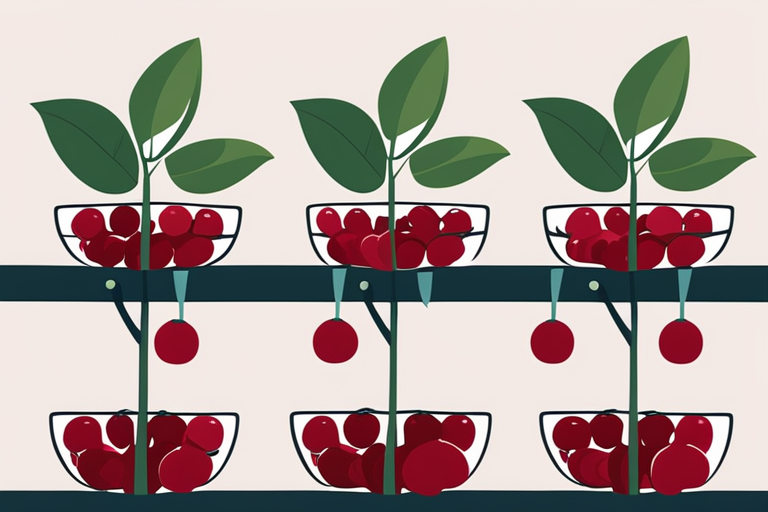
Signs that American Cranberries Have Gone Bad
Get Your Free Food Safety Cheat Sheet
30 most common foods with instant answers. Print it and stick it on your fridge—completely free!
Signs that American Cranberries Have Gone Bad
American cranberries are a popular and versatile fruit that can be enjoyed in a variety of dishes, from sauces to desserts. However, like all perishable foods, cranberries can go bad if not stored properly. In this blog post, we will discuss the signs that American cranberries have gone bad and provide tips on how to properly store them to ensure their freshness and safety. (American cranberry)
How to Tell if American Cranberries Have Gone Bad
Visual Signs
- Mold: If you notice any fuzzy white or gray mold on the cranberries, it is a clear indication that they have spoiled.
- Discoloration: Look for any dark spots or discoloration on the cranberries, as this can be a sign of decay.
- Wrinkled Skin: Fresh cranberries should have a smooth and firm skin. If the skin appears wrinkled or shriveled, the berries are likely past their prime.
Smell
- Foul Odor: Fresh cranberries have a tart and slightly sweet aroma. If the cranberries emit a foul or unpleasant smell, it means they have started to spoil.
Texture
- Softness: Fresh cranberries should be firm to the touch. If the berries feel soft or mushy, they have likely gone bad.
Taste
- Off Flavor: If the cranberries taste sour, bitter, or off compared to their usual tartness, it is a sign that they are no longer fresh.
Proper Storage Tips for American Cranberries
To ensure the longevity and freshness of your American cranberries, follow these storage tips:
-
Refrigeration: Store fresh cranberries in the refrigerator in their original packaging or a breathable container. Avoid washing the berries until just before using them to prevent moisture buildup.
-
Freezing: To extend the shelf life of cranberries, you can freeze them. Spread the berries in a single layer on a baking sheet and freeze until firm before transferring them to a freezer-safe bag or container.
-
Avoid Moisture: Moisture promotes mold growth and spoilage. Make sure to remove any wet or moldy berries from the container to prevent the spread of spoilage.
-
Check Regularly: Inspect your cranberries regularly for any signs of mold, discoloration, or softness. Remove any spoiled berries to prevent them from affecting the rest of the batch.
-
Use Fresh Berries First: When using cranberries for cooking or baking, try to use the freshest berries first to ensure the best flavor and quality of your dishes.
Importance of Food Safety when Handling Cranberries
When it comes to handling cranberries or any food product, food safety should always be a top priority. Here are some important food safety tips to keep in mind when dealing with American cranberries:
- Wash Hands: Always wash your hands with soap and water before handling cranberries to prevent the spread of bacteria.
- Wash Berries: Rinse cranberries under cold running water before consuming or using them in recipes to remove any dirt or bacteria.
- Separate Raw and Cooked Foods: To avoid cross-contamination, store raw cranberries away from cooked or ready-to-eat foods in the refrigerator.
- Store at Safe Temperatures: Keep fresh cranberries refrigerated at 40°F (4°C) or below to prevent bacterial growth.
- Cook Thoroughly: When using cranberries in cooked dishes, make sure they are cooked thoroughly to kill any harmful bacteria.
By following these food safety guidelines and storage tips, you can enjoy fresh and delicious American cranberries while minimizing the risk of foodborne illnesses.
Conclusion
In conclusion, it's essential to be able to recognize the signs that American cranberries have gone bad to ensure the safety and quality of your food. By paying attention to visual cues, smell, texture, and taste, you can easily determine if your cranberries are still fresh. Proper storage techniques and food safety practices will help prolong the shelf life of cranberries and prevent foodborne illnesses. Remember to always prioritize food safety when handling perishable foods like cranberries to enjoy them at their best. (American cranberry)

Authoritative Food Safety References
These agencies and university labs inform every tip and health precaution we publish.
USDA FoodKeeper – Cold Storage Guidelines
Official refrigerator, freezer, and pantry timelines maintained by the U.S. Department of Agriculture.
Visit USDA FoodKeeperFDA Produce Safety Rule & Grower Guidance
Field-to-fridge handling practices that prevent contamination of fruits, vegetables, and leafy greens.
Visit FDA Produce SafetyCDC Foodborne Illness Prevention Hub
Surveillance-backed guidance on pathogens, symptoms, and steps to reduce foodborne illness risk.
Visit CDC Food SafetyUC Davis Postharvest Technology Center
University research detailing optimal storage atmospheres for produce after harvest.
Visit UC Davis PostharvestPenn State Extension – Home Food Preservation & Safety
Peer-reviewed extension bulletins on safe canning, chilling, and reheating practices.
Visit Penn State ExtensionCan I still eat American cranberries after the expiration date?
How should American cranberries be stored to prevent spoilage?
Are there any health risks associated with eating spoiled American cranberries?
Can I freeze American cranberries to extend their shelf life?
Get Your Free Food Safety Cheat Sheet
30 most common foods with instant answers. Print it and stick it on your fridge—completely free! Want more? Upgrade to the complete guide with 70+ foods.
Scan your food directly and get instant safety info using our AI-powered camera feature.